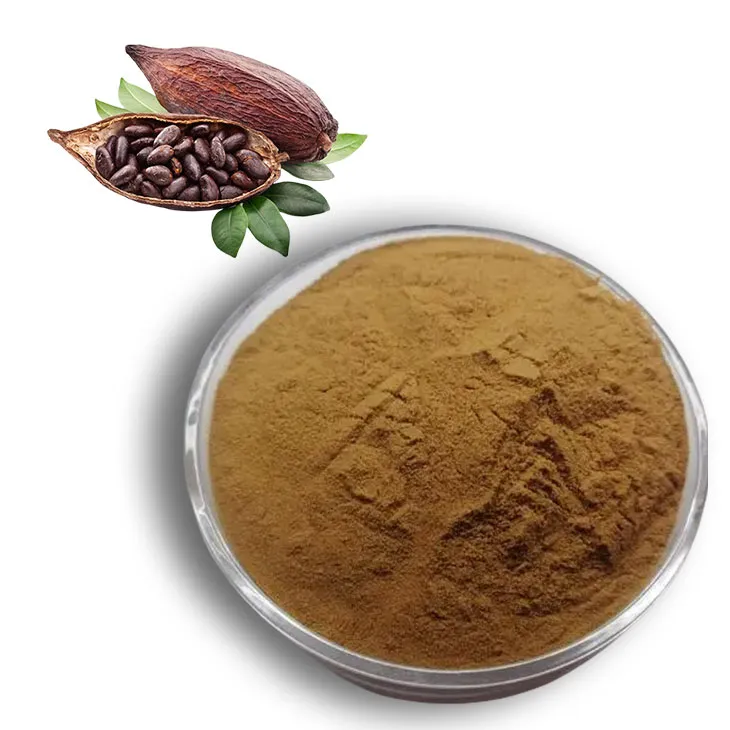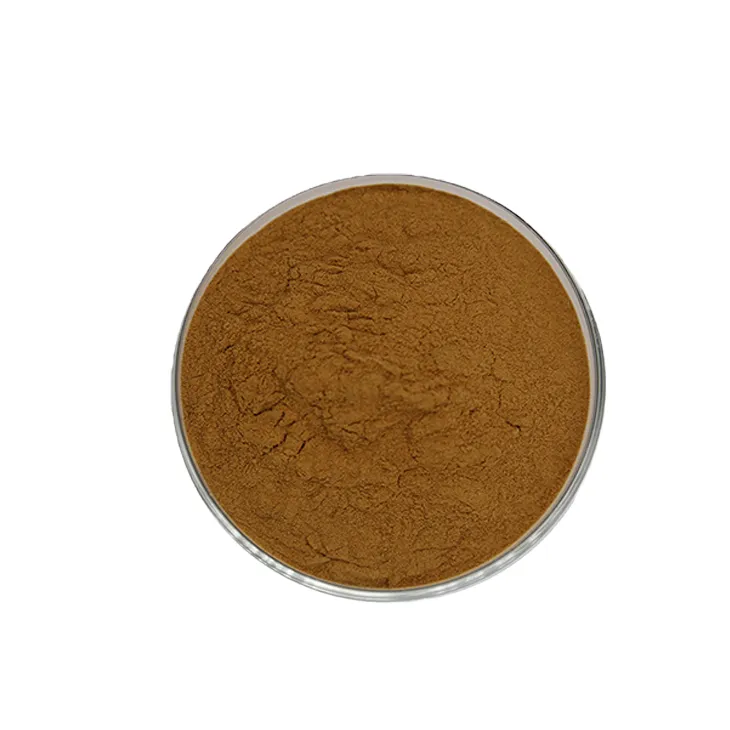- 0086-571-85302990
- sales@greenskybio.com
Optimal Bioavailability of Cocoa Extracts
2024-11-26

1. Introduction
Cocoa Extracts have gained significant attention in the health and nutrition field due to their potential health benefits. These benefits are attributed to the presence of various bioactive compounds such as flavonoids, polyphenols, and theobromine. However, the key to reaping these benefits lies in the optimal bioavailability of Cocoa Extracts. Bioavailability refers to the proportion of a substance that enters the circulation and is available at the site of action. In the case of Cocoa Extracts, it is crucial to understand how to maximize the body's absorption and utilization of these beneficial compounds.

2. Factors Affecting Bioavailability of Cocoa Extracts
2.1 Extraction Methods
Solvent Extraction:
- One of the most common methods for extracting cocoa components is solvent extraction. Different solvents can be used, such as ethanol, methanol, or water. The choice of solvent can significantly impact the bioavailability of the extracted compounds.
- Ethanol extraction, for example, is often preferred as it can effectively extract a wide range of flavonoids. Flavonoids are known for their antioxidant properties. However, the concentration of ethanol and the extraction time need to be optimized. If the ethanol concentration is too high, it may lead to the extraction of unwanted compounds, which could potentially interfere with the bioavailability of the desired flavonoids.
- Water extraction is a more natural and environmentally friendly option. It is particularly good at extracting water - soluble compounds like some polyphenols. However, water - only extraction may not be as efficient in extracting all the beneficial compounds compared to solvent - solvent combinations.
- This method uses supercritical fluids, most commonly carbon dioxide (CO₂), as the extracting agent. Supercritical CO₂ has properties between a gas and a liquid, which allows for more selective extraction.
- It can extract compounds without leaving behind solvent residues, which is a significant advantage in terms of product purity. This can potentially enhance the bioavailability as there are no unwanted solvent - related substances that could interfere with absorption.
- However, the equipment for supercritical fluid extraction is more expensive, which may limit its widespread use in the production of cocoa extracts.
2.2 Particle Size
- The particle size of cocoa extracts plays an important role in bioavailability. Finer particles generally have a larger surface area - to - volume ratio.
- When cocoa extracts are in the form of fine particles, they can be more easily digested and absorbed by the body. For example, if the cocoa extract is in a powder form with small particle sizes, it can be more readily dissolved in the digestive fluids, allowing for quicker access to the absorptive surfaces in the gut.
- However, extremely small particles may also pose challenges such as aggregation, which could reduce their effective surface area. Therefore, finding the optimal particle size range is crucial for maximizing bioavailability.
2.3 Matrix and Formulation
Matrix Composition:
- The matrix in which cocoa extracts are presented can influence their bioavailability. For example, if cocoa extract is incorporated into a high - fat matrix, it may have different absorption characteristics compared to being in a water - based matrix.
- In a high - fat matrix, lipophilic compounds in the cocoa extract may be more easily absorbed due to the presence of lipids that can enhance their solubility. However, this may also lead to slower release and absorption in some cases.
- Combining cocoa extracts with other substances can either enhance or reduce their bioavailability. For instance, when combined with certain vitamins, such as vitamin C, the antioxidant activity of cocoa extract flavonoids may be enhanced. Vitamin C can help to regenerate oxidized flavonoids, thereby increasing their effectiveness and potentially their bioavailability.
- On the other hand, some substances may interact unfavorably with cocoa extract compounds. For example, if cocoa extract is combined with a substance that forms complexes with its flavonoids, it could reduce the amount of free flavonoids available for absorption.

3. Digestive Processes and Bioavailability
Digestion in the Stomach:
- Cocoa extract enters the stomach where it is exposed to gastric juices. The acidic environment of the stomach can have both positive and negative effects on the bioavailability of its compounds.
- Some flavonoids may be more stable in an acidic environment, while others may be degraded. For example, procyanidins, which are a type of flavonoid in cocoa, may be partially hydrolyzed in the stomach, which could affect their subsequent absorption.
- The presence of food in the stomach can also influence the digestion of cocoa extract. If cocoa extract is consumed with a meal, the composition of the meal can either protect the cocoa compounds from degradation or promote their interaction with other food components.
- The small intestine is the primary site for the absorption of cocoa extract compounds. The absorptive cells in the small intestine have specific transporters and mechanisms for taking up different substances.
- Flavonoids, for example, may be absorbed through passive diffusion or active transport mechanisms. The solubility of the flavonoids in the intestinal lumen plays a crucial role in this process. If the flavonoids are in a form that is easily soluble in the intestinal fluids, they are more likely to be absorbed.
- Some polyphenols in cocoa extract may be conjugated during absorption. This means that they are chemically modified by the addition of other molecules, such as glucuronic acid or sulfate. This conjugation can affect their biological activity and further metabolism in the body.
- The gut microbiota also plays an important role in the bioavailability of cocoa extract. These microorganisms can metabolize cocoa compounds in ways that can either enhance or reduce their bioavailability.
- For example, some gut bacteria can break down complex flavonoids into smaller, more absorbable metabolites. However, other bacteria may produce metabolites that are less bioactive or even inhibitory to the absorption of cocoa extract compounds.
- The composition of the gut microbiota can be influenced by factors such as diet, lifestyle, and the use of antibiotics. Therefore, maintaining a healthy gut microbiota may be important for optimizing the bioavailability of cocoa extract.

4. Strategies to Maximize Bioavailability
4.1 Optimization of Extraction and Processing
- As mentioned earlier, choosing the right extraction method is crucial. For example, a combination of solvent extraction methods may be used to extract a broader range of bioactive compounds while minimizing the extraction of unwanted substances.
- After extraction, proper processing techniques such as drying and milling can be optimized. Controlled - drying methods can help to preserve the integrity of the bioactive compounds in the cocoa extract. Milling to the right particle size can also enhance bioavailability.
4.2 Formulation Design
- Designing the right formulation for cocoa extract products is essential. This includes choosing the appropriate matrix and combining it with complementary substances.
- For example, formulating cocoa extract in a lipid - based delivery system may be beneficial for lipophilic compounds. Additionally, adding substances like emulsifiers can improve the dispersion of cocoa extract in the formulation, which can enhance its bioavailability.
4.3 Dietary Considerations
- Consuming cocoa extract with certain foods can enhance its bioavailability. For example, consuming it with foods rich in healthy fats, such as nuts or avocados, may improve the absorption of lipophilic compounds in the cocoa extract.
- Also, pairing cocoa extract with foods rich in fiber can have a positive impact. Fiber can slow down the digestion process, allowing for more time for the absorption of cocoa extract compounds.

5. Conclusion
The optimal bioavailability of cocoa extracts is a complex concept that is influenced by multiple factors, including extraction methods, particle size, matrix and formulation, and digestive processes. By understanding these factors and implementing strategies to maximize bioavailability, such as optimizing extraction and processing, designing appropriate formulations, and making dietary considerations, it is possible to enhance the body's absorption and utilization of the beneficial compounds in cocoa extracts. This, in turn, can lead to more significant health benefits, making cocoa extracts a more effective ingredient in the realm of health and nutrition.
FAQ:
What are the main factors influencing the optimal bioavailability of cocoa extracts?
The main factors include the extraction method. Different extraction methods can yield different compositions and purities of cocoa extracts. For example, solvent - based extractions may vary in their ability to extract bioactive compounds. Formulation techniques also play a role. The way cocoa extract is formulated, such as in capsules or as part of a food matrix, can impact its bioavailability. Additionally, factors like the presence of other substances in the extract or in the body that may interact with the beneficial compounds of cocoa extract can influence how well the body can absorb and utilize them.
How does the extraction method affect the bioavailability of cocoa extracts?
Some extraction methods may be more efficient at extracting certain bioactive components. For instance, if a particular extraction method fails to extract a significant amount of flavonoids, which are important bioactive compounds in cocoa, the resulting extract may have lower bioavailability. Harsh extraction conditions might also damage some of the delicate bioactive molecules, reducing their ability to be absorbed by the body. On the other hand, a well - optimized extraction method can preserve the integrity of these compounds, making them more available for absorption.
Can formulation techniques enhance the bioavailability of cocoa extracts?
Yes, formulation techniques can enhance bioavailability. For example, encapsulating cocoa extract can protect it from degradation in the digestive tract, allowing more of the beneficial compounds to reach the absorption sites intact. Formulating cocoa extract with substances that enhance solubility or permeability can also improve its bioavailability. When cocoa extract is combined with certain lipids or emulsifiers in the right formulation, it can be more easily absorbed by the cells lining the intestine.
What are the beneficial compounds in cocoa extracts related to bioavailability?
Flavonoids are among the most important beneficial compounds in cocoa extracts related to bioavailability. They have antioxidant properties and can potentially have positive effects on health. Theobromine is another compound. These compounds can interact with the body's cells and physiological processes in ways that contribute to health benefits. Their bioavailability determines how effectively they can exert these beneficial effects in the body.
How can we measure the bioavailability of cocoa extracts?
One way is through pharmacokinetic studies. These studies measure the concentration of cocoa extract compounds in the blood over time. By analyzing how quickly the compounds are absorbed, reach peak concentration, and are eliminated from the body, we can get an idea of their bioavailability. Another approach is to study the excretion of the compounds in urine or feces. If a large amount of the cocoa extract compounds are excreted unchanged, it may indicate low bioavailability, while if they are metabolized and absorbed efficiently, it suggests higher bioavailability.
Related literature
- Bioavailability of Cocoa Flavonoids: Current Status and Future Prospects"
- "Optimizing the Extraction and Bioavailability of Cocoa Bioactive Compounds"
- "The Influence of Formulation on the Bioavailability of Cocoa - Derived Antioxidants"
- ▶ Hesperidin
- ▶ Citrus Bioflavonoids
- ▶ Plant Extract
- ▶ lycopene
- ▶ Diosmin
- ▶ Grape seed extract
- ▶ Sea buckthorn Juice Powder
- ▶ Fruit Juice Powder
- ▶ Hops Extract
- ▶ Artichoke Extract
- ▶ Mushroom extract
- ▶ Astaxanthin
- ▶ Green Tea Extract
- ▶ Curcumin
- ▶ Horse Chestnut Extract
- ▶ Other Product
- ▶ Boswellia Serrata Extract
- ▶ Resveratrol
- ▶ Marigold Extract
- ▶ Grape Leaf Extract
- ▶ New Product
- ▶ Aminolevulinic acid
- ▶ Cranberry Extract
- ▶ Red Yeast Rice
- ▶ Red Wine Extract
-
Pomegranate Extract
2024-11-26
-
Sugarcane Extract
2024-11-26
-
Honeysuckle Pollen
2024-11-26
-
Grapefruit Seed Extract Powder
2024-11-26
-
Andrographis Paniculata Extract Powder
2024-11-26
-
Plantain extract
2024-11-26
-
Acai Berry Extract
2024-11-26
-
Yellow Pine Extract
2024-11-26
-
Astaxanthin
2024-11-26
-
Nettle leaf extract
2024-11-26





















